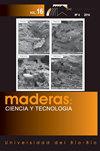木制和塑料托盘的碳足迹:用不同的软件工具进行量化
IF 1.5
4区 农林科学
Q3 MATERIALS SCIENCE, PAPER & WOOD
引用次数: 0
摘要
交通运输是产生最多二氧化碳当量的活动之一。在智利的特殊情况下,它是产生最大环境影响的第二大经济活动。国内外市场上产品的安全高效运输,往往借助于木材或塑料等各种材料制成的托盘进行,这些托盘在其生产中与不同的环保性能齐头并进。这就是为什么了解这些产品的碳足迹是很重要的。本研究的目的是比较当地生产木制和塑料托盘所产生的碳足迹的价值,并使用不同的软件评估其量化的变化。为此,以智利市场为参照。本研究遵循ISO标准的主要指导方针作为参考框架。功能单元为1个托盘生产,系统边界为从摇篮到闸门。结果表明,木材和塑料托盘的平均碳足迹分别为4.12千克二氧化碳当量和38.85千克二氧化碳当量。两种托盘之间的差异主要是由于原材料的环境负荷。不同软件的碳足迹估算差异的原因是基于它们可以使用的数据库。木托盘与塑料托盘的碳足迹之比为1:9,为决策提供了重要数据。碳足迹,ISO 14040, 14067,免费软件,生命周期评估,塑料托盘,木制托盘。本文章由计算机程序翻译,如有差异,请以英文原文为准。
Carbon footprint of wooden and plastic pallets: A quantification with different software tools
Transport is one of the activities that generates the highest CO 2 eq emissions. In the particular case of Chile, it is the second economic activity that generates the greatest environmental impact. The safe and efficient transport of products in domestic and foreign markets is often carried out with the help of pallets made of various materials, such as wood or plastic, which goes hand in hand with different environmental performance in their production. That is why it is important to know the carbon footprint of these products. The objectives of this study are to compare the value of the carbon footprint generated by the local production of wooden and plastic pallets and to evaluate the variations in its quantification using different software. For this purpose, the Chilean market is taken as a reference. This study follows the main guidelines of ISO standards as a reference framework. The functional unit is 1 pallet produced and the system boundary is from cradle to gate. The results show that wood and plastic pallets have an average carbon footprint of 4,12 kg CO 2 eq and 38,85 kg CO 2 eq respectively. The difference between the two pallets is mainly due to the environmental load of the raw materials. The causes of the variation in the estimation of the carbon footprint with different software are specifically based on the databases with which they can work. The ratio of 1:9 between the carbon footprint of wooden pallets concerning plastic pallets provides important data for decision making. Carbon footprint, ISO 14040, 14067, free software, life cycle assessment, plastic pallets, wooden pallets.
求助全文
通过发布文献求助,成功后即可免费获取论文全文。
去求助
来源期刊

Maderas-ciencia Y Tecnologia
工程技术-材料科学:纸与木材
CiteScore
2.60
自引率
13.30%
发文量
33
审稿时长
>12 weeks
期刊介绍:
Maderas-Cienc Tecnol publishes inedits and original research articles in Spanish and English. The contributions for their publication should be unpublished and the journal is reserved all the rights of reproduction of the content of the same ones. All the articles are subjected to evaluation to the Publishing Committee or external consultants. At least two reviewers under double blind system. Previous acceptance of the Publishing Committee, summaries of thesis of Magíster and Doctorate are also published, technical opinions, revision of books and reports of congresses, related with the Science and the Technology of the Wood. The journal have not articles processing and submission charges.
 求助内容:
求助内容: 应助结果提醒方式:
应助结果提醒方式:


